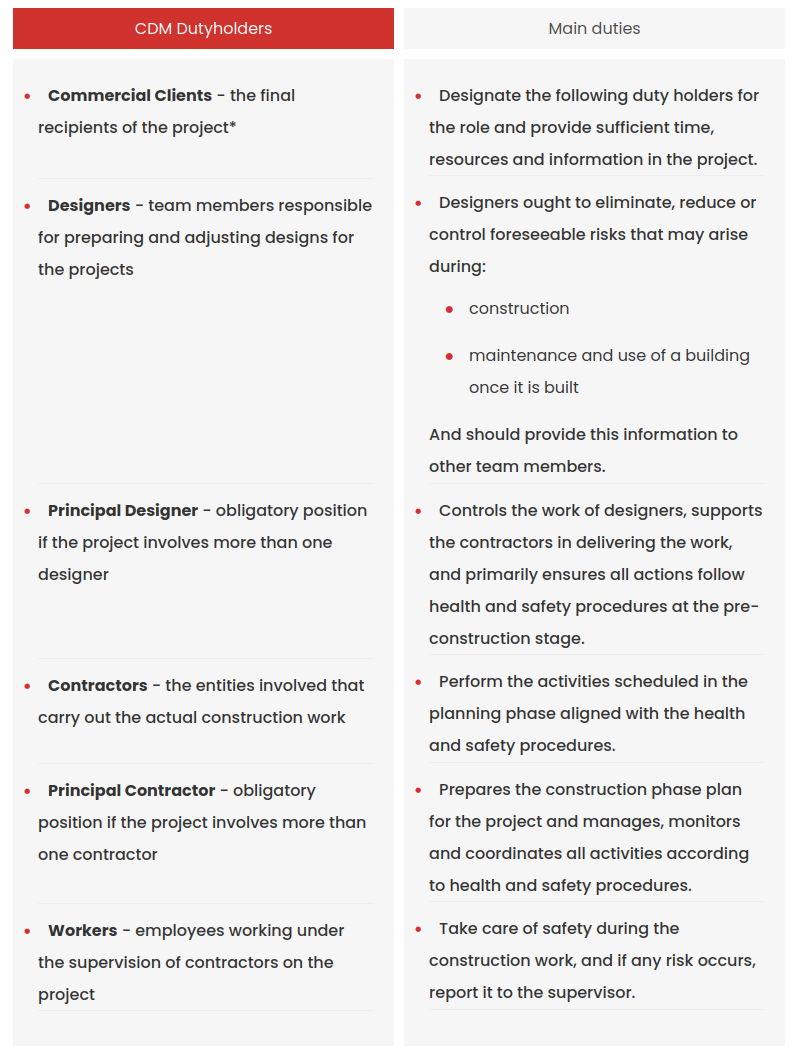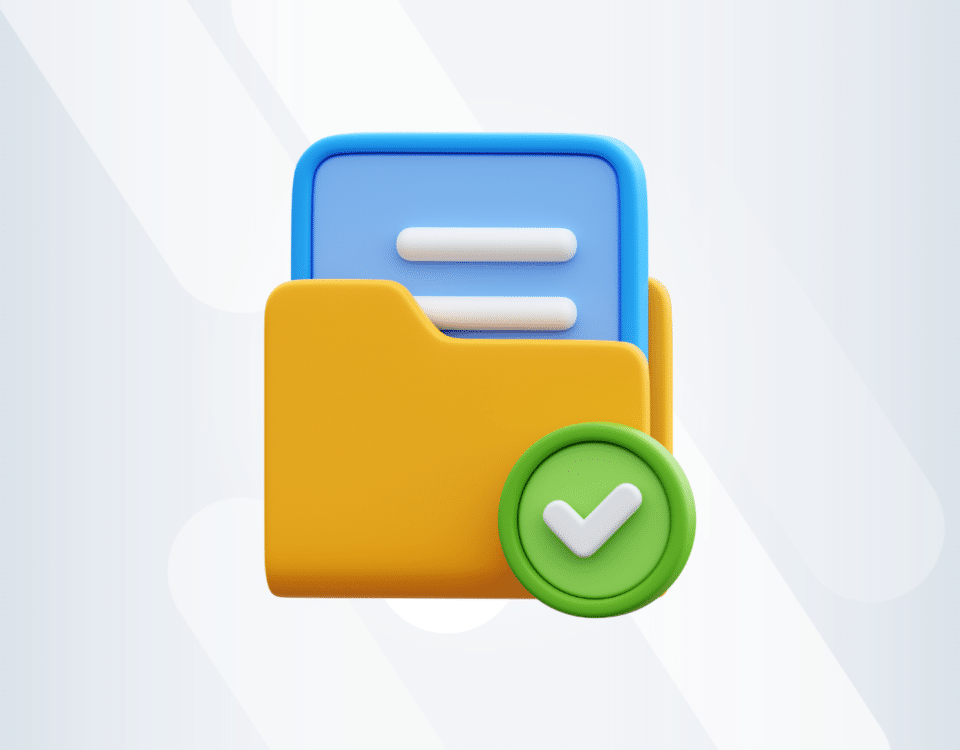Construction Tips, News & Best Practices
CDM Regulations for Health&Safety of Construction Projects:
All you need to know
Do you feel lost in the flood of regulations, procedures and documentation to fill out regarding health and safety measures on construction sites? Well, we are here to help you with it! Check out our guide about HSE CDM Regulations and execute your projects consistently in line with H&S guidelines.
Every year 61,000 workers suffer from non-fatal injuries
Only in 2020, 81,000 workers suffered from work-related ill-health
Due to workplace injuries and work-related illnesses between 2017 and 2020, around 2.1 million working days were lost
Can you imagine that these numbers concern only the UK market?
When it comes to health and safety measures, everybody in the industry agrees that it is a top priority. However, not everybody knows what to do and what actions to take to assure the project's safety. That is why today, we will take a look at CDM regulations, especially from the property developer side, and try to unveil the mystery of what they mean to your project.
What are CDM Regulations
CDM (Construction Design and Management Regulations) are health and safety procedures concerning any construction project executed in Great Britain. The main objective is to improve safety at every stage of the project work, from the first planning to the final execution.
There are two main reasons why CDM Regulations are crucial for any construction work.
CDM Regulations apply to any kind of project, even the simplest tasks that do not require the use of any machines.
Property Developers are legally responsible for project safety and there are specific duties that need to be fulfilled by each of the duty holders.
What are the Health and Safety Duties in a Construction Project?
CDM2015 regulations distinguish seven duty holders that means the positions with specific tasks to complete in order to execute their project in line with Health and Safety procedures. Regardless of the naming, each duty holder can be an organisation or an individual performing the following tasks:

source: https://www.hse.gov.uk/construction/cdm/2015/summary.htm
*The CDM2015 document also distinguishes domestic clients, but in this article, we want to focus mainly on the perspective of property developer companies.
The Construction Phase Plan - A Must Have of Any Project
A construction phase plan is a document that organises health and safety procedures on-site. It is an obligatory document for any construction project. Even though it must be completed before the work starts, the best approach would be to treat it as a live document constantly updated during project execution.
The document consists of three main parts:
Plan - the critical information about the project: company's name, time range of the project, names and addresses of the clients, delivery dates etc.
Working Together - explain who and how your employees should inform about safety and health issues in the project. Also, here you can add site rules, primary H&S information and procedures on how to update the team about any changes.
Organise - a crucial part of the document! Here, you need to identify the main Health & Safety dangers in the project and possible solutions to mitigate them.
Check out the example of a filled out construction phase plan.
30 Working Days or 500 Person Days - Does Your Project Need to Be Registered?
Another crucial aspect of the HSE regulations is the specification of your project. If your construction works last longer than 30 working days or exceed 500 person days, it means that your project is counted as notifiable and needs to be notified to the HSE.
But, let’s start from the very beginning. What exactly do these criteria mean?
30 working days
Intuition might tell you that eight or twelve hours count as one working day. Nothing could be more wrong! According to CDM regulations, a working day is any day during which there was completed work on the project. So it does not matter if it was 2, 8 or 12 hours. What's essential is that it only counts when there are more than 20 employees working simultaneously at any point in the project.500 person days
Here the calculations are pretty similar to the first criterion. No matter if your employees had one or a double shift, it is counted as one workday. Now, you just need to multiply it by the number of workers. For example, 25 employees working day shift and another 25 working night shift already give you 50 person-days.
What are the implications of having a notifiable project? According to the newest regulations, all projects need to have a Construction Phase Plan, so there are no additional documents to fill out. However, you must remember to notify HSE about your project, as otherwise, you risk financial penalties.
What are the legal implications of not following the CDM15 Regulations?
Until this point, you probably agree that the CDM regulations are rather general. However, even though they are not so strict, you are still responsible for fulfilling them.
Apart from the health and wellbeing of your coworkers, there is one more aspect that makes following CDM15 restrictions crucial: legal implications. According to the HSE policy, the inspectors can visit the site whether invited or not. If they state that CDM regulations are not being followed, the penalties can range up to ten million pounds or even imprisonment for up to two years!
It is worth highlighting that you risk financial penalties not only if you have broken the rules or knowingly ignored them but also if you failed to complete the documentation. For example, financial penalties are possible if you have not prepared the Construction Phase Plan properly. That is why it is worth considering a proper construction management tool that will help you keep the documentation organised in one place in case of an HSE control.
How can construction management software support you in fulfilling H&S rules?
Have you heard about the construction management platform? Such software can support you in managing both your projects and business, gathering all data in one place. Of course, the construction management system can offer many more solutions for your company but here, we want to focus mainly on H&S features.
To fulfil CDM regulations, a construction software, like Archdesk can support you with the following features:
- A
Document Management
Imagine that you immediately need to send one document, but it is impossible to find it on your Google Drive or Office Repository. A proper document management software can help you store your documentation and organise your work better, thanks to the customisable approval process. Never again missed H&S documents to fill out! - B
To-Do’s
Human memory is unreliable. That is why you shouldn’t count solely on yourself when completing all the CDM regulations. Instead, you can use To-Do's feature to better plan actions that need to be done and assign them later to your team members. - C
Forms
Let's say that one of the risks listed in your Construction Phase Plan occurred. As a property developer, you sometimes cannot notice it on your own. However, employees working in your project can. Form feature is a powerful tool that can help you faster communicate with your subordinates and react to the changes inside your project.
Interested to learn more about Archdesk’s solutions? Are you looking for software that will support you in following H&S regulations, completing everyday tasks and increasing profitability?
Request a demo to find out!
Key Takeaways
We live in the time when construction sites are much safer places than they were 20 or 40 years ago. However, there is still a lot to be done to increase safety.:
We wanted to give you all the crucial knowledge about the CDM regulations, whis is why we are now going to sum up the essential aspects:
CDM regulations apply to every type of construction project.
In a project with more than one contractor or designer, there is an obligation to create the role of a principal contractor and a principal designer.
There can only be one principal contractor and one principal designer in the project, at the same time.
Before construction works start, you must prepare the Construction Phase Plan.
If your project exceeds 30 working days or 500 person-days, the HSE (The Health and Safety Executive) must be informed.
If you do not meet the CDM Requirements or break them intentionally, you can face a financial penalty (or even imprisonment).
You can invest in a construction management platform that will support you in meeting all these requirements and in achieving better project delivery.
The last point is something we can help you with! Do you want to discover all Archdesk’s features and get more information about them? Do not hesitate to contact us!
You might also like
February 29, 2024 • 7 min read
Utilizing the human-first approach to construction projects to drive higher results.
July 3, 2023 • 6 min read
8 Best Construction Drawing Management Software (2023): A Comprehensive Guide
Find all the information you need about the construction drawing management software tools available on ...June 14, 2023 • 6 min read
The 11 Best PlanGrid Alternatives (2023)
Looking for a great alternative to PlanGrid software? Check out the 11 best construction software tools ...June 14, 2023 • 4 min read
How to win at CIS 340 and make taxes a breeze
CIS 340 is a legal obligation for contractors. But getting it right isn’t straightforward. Want ...





